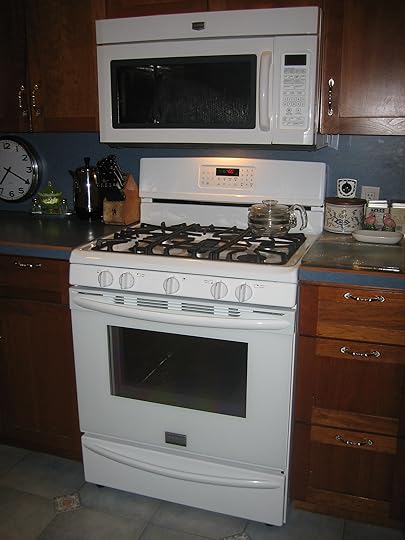Mike Jastrzebski's Blog, page 75
December 4, 2011
Changing hats
By Mike Jastrzebski
Those of you who have been reading this blog know that Mary and I were planning to leave last summer at the same time fellow blogger Christine Kling left. It was a hard decision but I had two books in need of rewriting and we decided it was more important to get these books out. Dog River Blues went live in August. Weep No More
went live in August. Weep No More went live 2 weeks ago. Now it's time to change hats and begin working on the boat.
went live 2 weeks ago. Now it's time to change hats and begin working on the boat.
The first thing I did was redo my writing area. I had my desk set up so that I could use an office chair. This was comfortable but took up a lot of room, so I got rid of the chair and rebuilt the desk so I could still do some writing.
Here's a picture of me writing this blog at the new desk.
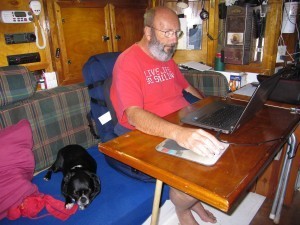
Over the next couple of weeks I will be rewiring some instruments, hooking up the ham radio, and tuning the engine. At the same time Mary will be finishing up her copy edit of Christine Kling's new book and sewing a new dodger.
We are shooting to get out of here sometime in February but that depends on whether we can stick to our schedule and whether we can get the engine running.
Mary and I are both finding that as we have aged we've slowed down. We still both work every day, but length of our workday has shortened since we did our rebuild 10 years ago.
As for the engine–it will either start or we'll have to get a mechanic in to look at it. We have an atomic four gas engine that is 30 years old. Every time I've made an effort to start it, it has started, but who knows. If it can't be started we will either have it rebuilt or put in a diesel engine.
I know, everyone will say put in the diesel, but it will cost twice as much as rebuilding the atomic four so we'll see. Hopefully it will start after the tune-up.
Anyway, over the next couple of months I'll be blogging more about working on the boat than writing. Once we get away from the dock I'll mix it up a little with blogs on cruising and blogs on the trials and tribulations of writing on the hook.
Kicking it up a notch…
Unfortunately, most lake sailors are fair weather sailors. If the winds are piping up over 20 knots, not many will go out. Contrast this with the steady 25 – 30 knot trades in the Caribbean. I would be willing to bet that less than 25% of the sailors on Georgian Bay, excluding racers, have ever reefed their sails. Most will drop them and motor in – if they even go out. While that saves wear and tear on the cloth, it means losing an on the edge of living experience.
My friend Diane, who boats with her husband Brian on Solway, a 27 CS, would cheerfully make this choice. Brian, on the other hand, just loves the challenge but wisely defers to Diane. I think he wants to keep sleeping with her if you ask me.
I recall my first bad weather sailing day. Three of us – a 38 Irwin, Brian and Diane's 27 CS and myself, were in at Hope Island. We had a 22 mile sail back to the marina in 30 knot winds, gusting. Once out of the lee of Beckwith Island, that wind was off the starboard bow almost all the way in. As we prepared to leave, I thought that perhaps I should reef since I was singlehanding. Turns out I was right to think that.
One of the things you read in the sailing mags is that you should reef early. That means that if you think you should reef when you start out, you should. I didn't. I bashed my way through ten miles of four to six foot waves, spending a lot of time with my toes curled tightly onto the leeward coaming looking down at my feet instead of across at them. I finally gave up and hove to in order to take the sails down. I was too tired to continue sailing with reefed sails anyway. The jib of course, resisted my efforts strenuously, tangling its halyard at the top of the mast. I think it only came down because I frightened it with what I was yelling at it.
Upon my return, I found one batten pocket torn out and three tears in the mainsail's seams and two more in the jib. An evening with a needle and palm sorted that issue out. The most valuable thing I learned that day however was just how much my first boat, Publisher's Choice, would take. Even though conditions were difficult and the boat was overcanvassed, she had handled well. Had I shortened sail to my second reef points, I have no doubt I could have sailed her in.
The other thing I learned was that I had confidence in my boat. I knew she wasn't going to let me down, provided I didn't do anything stupid. While I was not enjoying myself all that much, I wasn't frightened. In fact, a large part of the decision to drop sail was that I could see that the sails were taking a beating and I had already seen enough of my sailmaker for that season. I wasn't looking for a volume discount if I could avoid it.
In retrospect, I should have perhaps waited out the weather and returned the next day, thus missing a day of work. I didn't even think of it and wouldn't you know it, the next day was a perfect sailing day. Never fails.
As well, I should have had my battery checked. The VHF would not operate because the battery was not holding a charge properly. Had I gotten into serious difficulties, I was on my own, the others having fired up their diesels and motored on ahead. While they tried to contact me on the VHF, they couldn't know mine wasn't working properly. Had I chosen to sail back to the anchorage or ducked in somewhere, I would have triggered a search by doing so, my friends having assumed that I had gotten into trouble.
George, from the Irwin, was waiting at my slip when I returned, with a dock line, a tall glass of rum and an offer of dinner on his boat with more rum. It doesn't get any better than that.
That day was a learning experience, which is what you call the things you do that you get through without killing yourself – and I don't regret it in the least. I have resewn my sails, checked all the seams, learned how and when to reef and replaced the faulty battery. I also check sails, fuel levels, the VHF and batteries at the beginning of each sail now. Just because I got through it doesn't mean I want to do it again..
And just what did I learn? Well, you are going to eventually get caught in bad weather. Before that happens, learn how to handle your vessel under controlled conditions or with someone knowledgeable on board to guide you through. Make sure your gear can handle the situation. Most importantly, do it on someone else's boat if you can and keep the wear and tear on your gear down!
In the long run, simply knowing you can handle your boat in heavy weather, and that your boat can handle it too, is invaluable. And lastly, you'll know to make sure there's someone at the dock with rum when you finally arrive. You'll need it!
Share on Facebook
December 1, 2011
Serendipity II
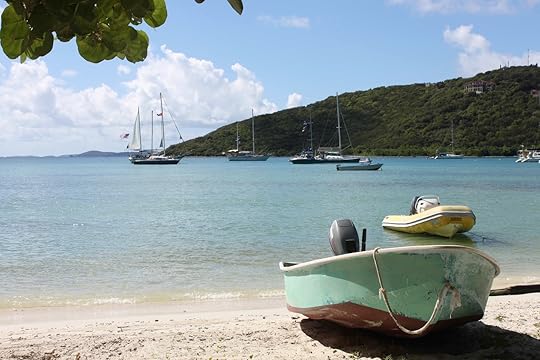
Liahona in the middle of the bay off Foxy's, Jost Van Dyke
Ten months ago, I wrote a blog post on the power of this word. Serendipity means a happy accident or a pleasant surprise. It is when something good happens to you when you are not expecting it. The first time I wrote about quitting my job to live on a boat and write full time and how my fears almost kept me from living that dream – but a kind comment by a student gas me the courage to move forward. These past couple of weeks, again, I have found myself nearly ready to give up (on getting to Tortola), when events conspired to put me back out to sea. I think serendipitous things happen to those who are open to the possibility.
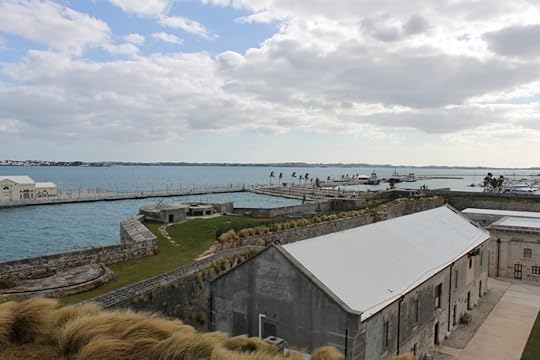
Royal Naval Dockyard, Bermuda
So, my unexpected arrival in Bermuda aboard the catamaran that was towing a fully inflated and brilliantly-lit liferaft nearly cut short my voyage to the BVI's. But the serendipity was that I would get to visit the one location in my soon-to-be-published novel that I had never seen: the Royal Naval Dockyard at Bermuda which was the last place that my submarine Surcouf was seen before she vanished off into the Atlantic never to be seen again. On Saturday, I spent two hours on buses each way crossing the island to visit the grounds and museum and to discover that two or three details of my description of the place were completely wrong. Luckily, I can revise it now before I send it out into the world.
While I was off at the dockyard, my friend and the professional skipper Jan talked to the folks on the Cherubini 44 Wavelength. They were also in the Caribbean 1500 and had stopped in Bermuda due to the lack of wind and a couple of crew members who feared it was going to take them weeks more to get to the islands. 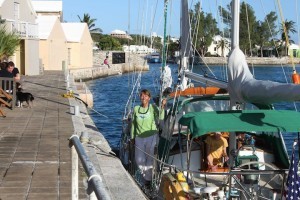 We'd lost our boat, they'd lost their crew, and PRESTO! we were back in business. The next morning we tossed our packed bags into the dinghy by 8:00 a.m. and my friend Jan and I were on board our new ride. We put to sea just before 4:00 p.m ready to cover the 850 or so miles to Tortola. Because so many boats had pulled into Bermuda for one reason or another, Mark and Eileen, the owners of Wavelength, announced we should nickname the second leg the Bermuda 850.
We'd lost our boat, they'd lost their crew, and PRESTO! we were back in business. The next morning we tossed our packed bags into the dinghy by 8:00 a.m. and my friend Jan and I were on board our new ride. We put to sea just before 4:00 p.m ready to cover the 850 or so miles to Tortola. Because so many boats had pulled into Bermuda for one reason or another, Mark and Eileen, the owners of Wavelength, announced we should nickname the second leg the Bermuda 850.
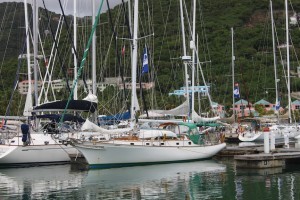
Wavelength - a Cherubini 44
Wavelength was a fun boat to sail with her sleek lines patterned after L. Francis Herreshoff's Ticonderoga and her ketch/cutter rig. On our third day at sea, we passed another sailboat, a Little Harbor 44, and we charged past doing eight and a half knots with all canvas flying. Later in light air, we broke out the mizzen staysail and the drifter and the light colorful nylon sails had us going more than half the apparent wind speed. We had great time, caught lots of fish, sailed well and arrived in Tortola at 10:00 p.m. on the sixth day.
Of course, our first trip was to the bar for a round or two of Painkillers, but when I made it to the shoreside showers around 3:00 a.m., I was toting my laptop to log on to Internet to see what had happened to Write on the Water when I missed posting (thanks Mike for posting something for me) and I checked my email. There was a note from a friend telling me that some other good friends were docked just across the Sir Francis Drake Channel in Virgin Gorda Yacht Harbor.
So that is how I got the serendipitous opportunity to hop on Speedy's ferry from Tortola to Virgin Gorda and join these wonderful folks, Mark and Willie Haskins, aboard their Nautical 60 Liahona – my third boat this trip.
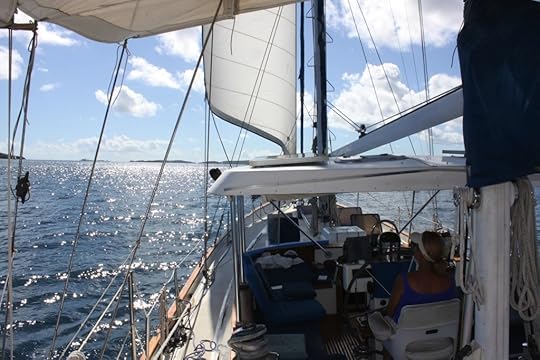
Willie sailing Liahona through the narrows
First, I didn't think I was going to make it to the V.I. at all, then I thought I would arrive and immediately have to fly back to Lauderdale, and now thanks to serendipity and the generous hospitality of these fine friends, I am getting to take this sail through my good memories of chartering our boat Sunrise in these waters almost 30 years ago.
So, on Saturday I will fly back to Fort Lauderdale, and I am determined that I am not going to fly north to New Bern to rejoin my boat until I have published CIRCLE OF BONES. Each day it will be getting colder as I go through these last copy edits, and I'd better go fast before I really do need an ice breaker to get my boat south. I have saved a photo to remind me of the islands when the pressure and all the errors found by my copy editor get me down.
Yes, indeed, the world is big, and I hope serendipity will give me the chance to sail even more of it.
Fair winds!
Christine
Share on Facebook
Sorting boats…
C.E. Grundler
[image error]
December has arrived, and once again the docks are all but empty on my little corner of the Hudson River. Activity at the yard, which had been buzzing along in high gear for the last two months, starts to scale back. For a few weeks there were people and cars and sounds of all sorts around us on the hard, but now the silence is returning. In another week or two, the only signs of life we'll see around the yard are a few marina employees and the hardy little feral 'yard cats', occasionally soaking up a bit of low winter sun on a warm car hood. The season has ended and rows of boats have been sorted.
In most cases, when yards block up boats for winter storage, there's a very specific order to where each one winds up, and why. Size plays a role, as does the all-important 'When do you want to go back in' factor. Last out is usually first in. Some owners wrap things up after Labor Day and don't pull the cover until the end of May while others are geared up for fishing at the first signs of spring – don't block them in! But there's more to it. It's no accident that the shiniest and newest of boats with custom covers or shrink wrap are closer to the main entrance and offices. For one, it just looks better and reflects well on the yard. It also keeps these boats where they're less inclined to be visited by someone other than their owner. Further back goes to the boats with flapping plastic tarps or no covers at all. And finally, tucked in the furthest corners of the yard, backed to the brush and overgrowth, are the boats that have been on the hard for many seasons – the hopeless and the forgotten. They sit as testaments to abandoned dreams. At some point in their existence, each had been someone's pride and joy. Now they stand as silent reminders of failed aspirations. Perhaps their owner had fallen upon bad times or eventually the reality of boat ownership outweighed the dream, draining and straining finances and relationships, sometimes past the point of no return. Like a novel in a desk drawer, these grand dreams fell victim to the harsh realities of day-to-day life.
Yet, glimmers of hope spring up in these forgotten corners, like a rose blooming among the oil drums and weeds. Every so often someone with the right mix of skill, perseverance, delusional optimism and determination sets their eyes on one of those forgotten boats, and you'll see it re-emerge from death-row to float and sail once more. I recall one boat where the cabin and bridge had been partially destroyed by fire, though the hull and engine remained intact. It was placed in the corner to languish for years. But then one day someone new arrived. The fellow who repaired her did so the only way he knew how — with sheet-metal. It wasn't exactly pretty, but year after year he's out on the water happily fishing away. On the other end of the spectrum a friend of mine acquired an old ketch that had been caught in the wrong end of a shed collapse, and he restored that boat to exceptional magnificence. In both cases, these boats were brought back from the dead and each is a victory. It's that ability to see beyond the work to the potential, to press on in the face of all adversity, hoping someday it will be beautiful — or at least float. I sometimes wonder how many of those resurrected boats belong to writers.
Share on Facebook
November 29, 2011
Ready To Go
I am offshore en-route to Colombia. See my current location on SPOT.
I thought I might need Mike to fill in or post a canned article this week because I am offshore. Instead in this amazing world I am online via Exumas Wi-fi at Big Majors anchorage with the swimmming pigs and James Bond's Thunderball groto. It is a great anchorage, protected on three sides. The local fare is slim, but you can get some supplies at Staniel Cay including meals out of the yacht club. There is gas and diesel.
Tonight (and I write this on Sunday, the 27th) we finally take off for a super clear weather window to Colombia. With the owner and Peruvian consult aboard we are take it easy. There has been little praying to Buddha so far though I expect that to change no matter what Commanders wx service says.
Best story I have so far is almost loosing our dinghy. I tied a sloppy knot and sure enough, the consult shortly later started gesticulating in the direction of the freely floating dinghy ( he only speaks Spanish and French, other crew speak French, I speak a little Spanish). I am a world class swimmer so jumped in and quickly got aboard the fastly departing dinghy.
A strong westerly current is running through the anchorage. As I climbed aboard I found that I had forgotten the key! I tried the oars, but there are no oar locks. I was drifting past a Morgan 41OI and tried to throw my line to the owners but missed. In the meantime our gracious owner had jumped over board with the key to swim out to me. But with the current running through that anchorage he did not have the fitness.
I jumped overboard and was able to swim the dinghy to the Morgan 41OI. I knew those 3 miles I swim every morning would come in handy someday. Then another dinghy came and dragged our dinghy as well as saving our out to sea capitan back to the yacht. I swam back and tied a fierce bowline. I have been tied careful bowline at every dinghy stop since.
Anyways I am ready to get moving. I like fast pace deliveries and this sultry stay at Thunderballs grotto has gone too long. I would rather be praying to Buddha, so here we go. Good to relax but nothing better than 3 on, 3 off watches nonstop offshore.
Share on Facebook
November 28, 2011
Stocking stuffer ideas from guest blogger Zuzana Prochazka
Tom Tripp is taking a couple of months off to work on his novel. Guest Blogger Zuzana Prochazka will be filling in through the end of the year.
Great Gear for Stocking Stuffers
By Zuzana Prochazka
Want to find that great gift for a salty sailor but just can't stuff a windlass or a fighting chair into a stocking? Check out these ten perfect presents that will go a long way to making Christmas morning a real joy – most are under $50.
ITunes Gift Card for Marine Applications
OK, this one is a no brainer for any boater with an iPhone. There are so many great boating apps and a $25 gift card to the iTunes App Store will make your sailor sing. www.apple.com/itunes.

Award winning Navionics has brought a chartplotter literally to the palm of your hand and now it's easier than ever to download large sections of chart data. For example, you can download the entire East Coast or Great Lakes for $9.99 each. You can view charts with a satellite overlay, do route planning, set waypoints, find marinas and shipping lanes and more. The zoom creates crisp, clear chart sections that give you great detail including depth contours, aids to navigation and hazards just like a dedicated marine chartplotter.
ShipFinder makes your iPhone into an Automatic Identification Receiver (AIS). This is a great safety app that gives you information from vessels in your vicinity that are broadcasting data about their speed, course, size and more. In most cases you even get a photo of the ship, all for $4.99.
AyeTides displays tides and currents for nearly 10,000 stations worldwide. You can choose a station alphabetically, geographically or nearest your location based on the phone's GPS. You get sunrise, sunset, tide height and direction and a graph of that day. You can even jump to maps to see where the station is located – just $7.99.
LightRule
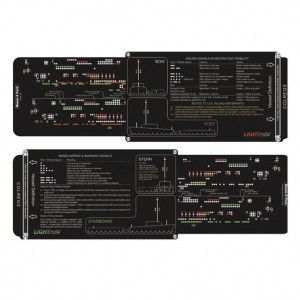
Do you ever look at lights of other vessels when you're running at night and wonder what kind of boat that is, and is it coming, going, or towing? How about deciphering those pesky day shapes or whistle sounds in the fog? Here's a handy new reference tool that can help you identify what you're looking at or hearing in just a second.
The LIGHTrule by Weems & Plath is a vessel identification tool that shows you 60 light configurations and what the boats will look like in the dark from port, starboard, on the bow and aft of the stern. Once you've dialed in the lights, the identification of the kind of vessel appears in a magnified description at the end of the slider.
Additional information includes configurations of day shapes, and whistle, horn and bell sounds for maneuvering, warning and restricted visibility. The LIGHTrule is a great reference tool that can be kept in the cockpit day and night. It also makes a great study aid for navigation classes and Coast Guard exams.
The LIGHTrule is made of durable plastic that is approximately 16" x 5" and is stored in a vinyl sleeve. The suggested retail price is $25.00 – read more on www.weemsandplath.com.
Seawatch UV Sensor
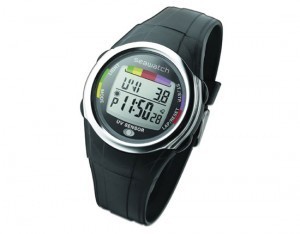
It's tough to tell the level of sun damage you are inflicting on your skin and eyes over the course of a day on the water, especially if you can't feel the sun due to the wind. But here's help in the form of the Seawatch by JDC, a digital chronometer with a built-in UV sensor which continuously displays the UV index and provides the wearer with instantaneous and accurate ultraviolet radiation data. The Seawatch alerts you to the maximum amount of recommended UV exposure and displays the index recorded. You need to point the watch so the sun's rays hit it at a right angle for the readings, which adjust every ten seconds, to be most accurate.
The Seawatch also displays hours, minutes, seconds, month, day and year and can be used as a fitness watch because it will count elapsed time and lap time. The Seawatch even has a countdown timer with beeps for the last five seconds so it can be used as a simple start watch on race day.
The Seawatch is about the size of a large wristwatch, is waterproof and has backlighting, timer and alarm functions. It retails for $49. Check out more information on www.oceanequipment.com.
Solio Bolt
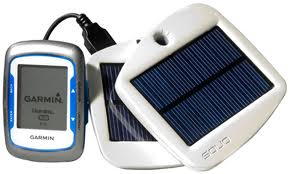
Charge your cell phone, Bluetooth headset, iPod, GPS, camera or other mobile gadget while lounging on the sundeck with the Solio Bolt, a solar cell charger that keeps you powered up and connected in remote locations. Solio scaled down the size and price of their classic solar chargers so the Bolt is abround $70 but it will charge over 3000 devices and since it's roughly 3.5" x 3.5", you can slip it in your pocket when not in use.
The Bolt has an internal lithium battery that will charge via the sun, a USB cable or an optional wall charger. The power output is 4 watts and one full Solio charge will give you about 3 hours of iPhone talk time. This handy little battery booster will hold a charge up to one year so it's always ready and it will never cause damage through overcharging. Check out www.solio.com.
EZ Splice Fasteners
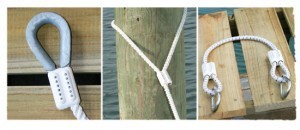
Splices can be a thing of beauty but unless you have the skill and the time, you can't beat EZ Splice fasteners that let you simply hammer your way to a custom spliced solution. Just cut a line, tape the end with the included tape, place that end in the fastener and drive in 6 stainless steel pins with a hammer. Then insert the remainder of the line in the other side of the fastener to make an eye any size you like and drive in 6 more pins.
The fasteners work with three strand, braided, nylon, polypropylene and polyester line. They won't rust and are UV and corrosion resistant. These patented polymer fasteners even work with shock cord to make stretchable spring lines and they're strong too as the line will fail before the fasteners do.
EZ Splice fasteners come in two sizes: ½" for line 3/8" to ½" and 5/8" for line 9/16" to 5/8". They are available in white, black or blue and retail for $20-25. More at www.ezspliceusa.com.
Princeton Tec Remix Headlamp
There are lots of headlamps available but the new Princeton Tec Remix is light, bright and affordable at only $45. The Remix has three 5-watt LEDs which are red to preserve your night vision and one Maxbright white LED for spotting at a distance. Both the distance and proximity lighting can be set at high or low levels to provide the amount of light you need. A large push-button switch is easy to find even with wet hands or gloves and the one-point swivel on a bracket lets you aim the beam wherever you need it.
Weighing in at just under 3 ounces, the Remix is lightweight and doesn't require a heavy battery back at the back of the head. The battery compartment is easy to open with a positive snap closure. The Remix packs a powerful 45 Lumens which means it's bright but has a burn time up to 200 hours on only 3 AAA batteries which are included.
The Remix features a comfortable headband, is water resistant to IPX4 standards, and carries a one-year warranty. For more information, visit www.princetontec.com.
Stowmaster Marine Horn
Make a little noise with this tiny air horn that doesn't require a canister of compressed air to operate. You won't believe you ears, but you might want to cover them when testing the Stowmaster Marine Horn. Made of durable plastic and measuring only 3" x 2", the horn is a safety tool that's so small it's more likely to be taken along in the dinghy or on a kayak and it's easy to toss anywhere near the helm or just hang it by its included lanyard.
Keeping a horn nearby means it'll be used when needed and it will never run out of air, so long as you don't, since it needs only a good blow by the user to produce a sound that will make you try it twice. It's also an excellent emergency backup for your ship's horn or you can put it in your ditch bag. The sound requires minimal air pressure and is directed downward for hearing safety.
A small horn might seem like an oxymoron, but if its size makes it more convenient to use, then it's worth a hundred larger horns that are out of reach when needed. The Stowmaster horn comes in a bright orange so you can find it quickly in a dark drawer or locker and it retails for $8.99 so grab two. For more information, visit www.westmarine.com.
Liquid Image Scuba Series Dive Mask
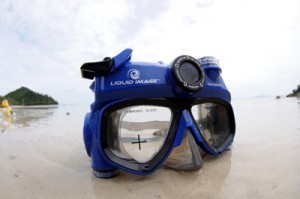
Now you can shoot great underwater pictures with a camera that doesn't require you to hold it. Liquid Image has a line of dive and snorkel masks that feature an integrated camera and their latest is one that does both stills and video. The Liquid Image HD320 is part of their scuba series and is a high definition, waterproof, 5 mega pixel digital camera you wear on your head since it's built into a quality scuba mask. Just line up the image with the crosshairs on the lenses and shoot. LED lights inside the mask's viewing area indicate if it's in still camera or video mode and you can take pictures or get video and audio by pressing a button on the outside of the mask. (Not sure what that underwater audio would sound like – maybe bubbles?)The series offers a large and medium mask skirt in a soft, transparent grey silicone for different sized faces. The Scuba Series HD 320 is good to 115 feet of depth. The HD320 features an internal memory of 64 MB but you can upgrade it with a SD/SDHC card up to 32 GB which will hold over 36,000 images or 16 hours of video. The lens is fixed and the sensitivity is ISO 100-200. It has attachments for optional side lights to help you light the subject in the murky depths and there is a choice of optional filters as well. You can use four AAA alkaline batteries that will provide enough power for 500 stills or 16 minutes of video. Lithium batteries will give you 2000 stills and 2 hours of video so the extra expense for those batteries might be worth it. The DiveCam isn't much heavier than a regular mask, weighing in around 13 ounces or just shy of a pound and that includes the batteries. You can find the HD320 at various online sources for $250. For more information, visit www.liquidimage.com.
Full Throttle Water Sports Gloves
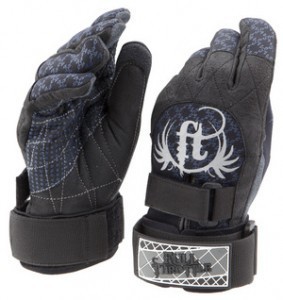
Wakeboarding and waterskiing are terrific sports but ohh, do they hurt the hands. Many a day, I'd come out of the water with blisters on my palms or even had the rope handle pulled out of my hands by the force of the boat. Gloves are key in tow sports and Full Throttle, an AbsoluteOutdoors brand, has a pair of performance gloves that won't break the bank.
The Full Throttle G110 gloves feature a dual layered palm that is reinforced so they're tough. The yalso have a raised grip for better holding power when you're pulling across the wake. The gloves are adjustable with turn-back straps and a secure hook and loop closure. There is also a grab tab on the wrist for easy adjustments and a knuckle guard for extra protection.
We all know how new gloves are tough to break in but the G110s stretch easily and are pre-curved so they're comfortable out of the box and your hand won't fatigue while fighting to wrap around the handle. And here's an interesting little bit of versatility, the gloves can double as cold weather ski gloves or water sports gloves in the summer. The G110 gloves retail for $27, which is about half the cost of high-end tournament gloves, and come in sizes from small to extra large. To purchase or for more information, visit www.absoluteoutdoorinc.com.
All Terrain Biodegradable Sunscreen
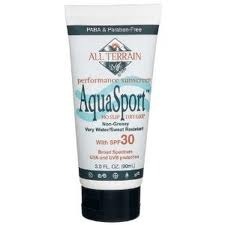
While you're out having fun, don't forget to protect that sensitive skin. Active lifestyles, especially boating, mean you'll need to take extra care with sunscreen not only because the protection can wash or sweat off, but also because the intensity of exposure is heightened by the glare from the water. There are lots of sunscreens available but they're not all created equal. All Terrain, a New Hampshire company, offers a line of biodegradable sunscreen that's all natural and really works.
AquaSport provides UVA/UVB protection and is based on zinc oxide so it's great for sensitive skin. Eye irritation is reduced and it's sweat and water resistant to it stays on longer. The product is FDA approved and also free of oxybenzone, avabenzone and nannoparticles. This means it's better for the environment as well as your health and it comes in a no-slip tube so it's easy to hang on to.
AquaSport comes in SPF 15 and 30 and you can get it in a lotion or an easy-to-apply spray. A three ounce tube of SPF 30 sells for $10.99. All Terrain also has a full line of other sunscreens including KidSport, TerraSport and their cold weather protection, WinterSport. For more information or to purchase, visit www.allterrainco.com.
Zuzana Prochazka. Zuzana is a freelancer and a regular contributor to Sea Magazine, SAIL, Latitudes and Attitudes, Lakeland Boating, Yachtworld and Boats.com. Her work has appeared in Santana, Voyaging, Good Old Boat, Reeds Nautical Almanac, and the Los Angeles Times Sunday Magazine, as well as online at underwatercolors.com, sailingbreezes.com, catamarans.comand floridascubanews.com. She is president of Boating Writers International (BWI) and has served as Innovation Awards judge at the IBEX, Miami, and MAATS shows for several years. Currently, she serves as the chairperson for the BWI New Products Committee and as a judging chair for the BWI Annual Writing Contest. Zuzana's gear and boat review blog is TalkoftheDock .
Share on Facebook
November 27, 2011
From Rags to Riches: September/October sales and earnings
In September I sold 556 copies of my books on Amazon. The breakdown was 239 copies of Dog River Blues (A Wes Darling Mystery) , 223 copies of Key Lime Blues (A Wes Darling Mystery)
, 223 copies of Key Lime Blues (A Wes Darling Mystery) , and 94 copies of The Storm Killer
, and 94 copies of The Storm Killer . In September I earned $1115.00 from my Kindle Sales.
. In September I earned $1115.00 from my Kindle Sales.
Sales in October were a bit better with 643 Kindle books sold. The breakdown was 334 copies of Dog River Blues (A Wes Darling Mystery) , 203 copies of Key Lime Blues (A Wes Darling Mystery)
, 203 copies of Key Lime Blues (A Wes Darling Mystery) , and 106 copies of The Storm Killer
, and 106 copies of The Storm Killer . In October I earned $1291.00 from my Kindle sales.
. In October I earned $1291.00 from my Kindle sales.
While I'm on the subject of sales, let's take a look at November sales. Up until the 20th I was on track to sell over 600 Kindle books, but my sales took a dive this past week. Was it the holiday? I don't know, but right now it looks like I'll sell about 525 books for the month. This surprises me since I just published my newest book, Weep No More . Weep No More is a psychological thriller. Here's the cover:
. Weep No More is a psychological thriller. Here's the cover:

To purchase Mike's books for the Barnes and Noble Nook click here: Mike's Books for Nook.
To order Mike's books for all other e-Readers: Mike's books at Smashwords
Share on Facebook
November 26, 2011
Airplane Sales: Ebooks Promotion
By Carol Newman Cronin (http://carolnewmancronin.com/CNC/default.htm)
I've been on a lot of airplanes since Game of sails (http://carolnewmancronin.com/CNC/booksother.htm) first came out in early July, traveling for both work and sailing. And on most of those flights, my seat companion has pulled out a Kindle or a Nook as soon as we were above 10,000 feet.
"Like your ereader?" I ask. (I have trouble telling the difference between the brands.)
"I love it," the seat mate gushes. And that simple exchange leads to a great discussion about favorite books, authors, and the joys and trials of ereaders (so easy and nondescript to carry, so frustrating to turn off in the middle of a chapter for take off and landing).
Almost always, this conversation gives me an opening to pull out my best ebook sales tool: a business card with the cover graphic on one side and a QR code on the other that leads directly to the Amazon and Nook download pages for Game of Sails.
"I'll buy it as soon as we land!" is the most common response.
Now none of these folks are sailors, though many have a passing interest in the sea. So why (frankly) would they be eager to buy an Olympic love story about sailing from someone they happened to meet on an airplane?
The reason is that at $2.99 (with a free preview), there's no need for anyone to think twice about checking out my latest book. And the business card makes it easy for an airplane companion to remember my name (and the book's name) after we part ways.
Another reason it's easy to sell ebooks while traveling is that an ereader weighs the same no matter how many books it includes. I have not (yet) sold a hard copy of Oliver's Surprise or Cape Cod Surprise on an airplane—although I've given out quite a few bookmarks. Nobody on a plane wants one more thing to carry—even a thin paperback. And $9.95 may be a great price for an entertaining read, but it's above the impulse buying limit for most people seated in coach.
What I'm learning is that there is no one right way to promote an ebook. As DE Karlson recently tweeted, "There are 3 rules to successfully sell e-books, unfortunately no one knows what they are."
So until someone figures out those rules, I'm gonna keep handing out my business cards. Even if my next seat mate doesn't buy my book, at least our conversation will make the flight go by quicker.
PS Thanks to the Write on the Water community, which is where I first got the idea for business cards with QR codes!
Share on Facebook
November 25, 2011
Where's Christine?
I haven't heard from Christine yet so I don't know where she is. She was due to post today and I'm sure if it eas at all possible she would have done do. She may still get a post in later today or tomorrow. If not, look for her post next Friday.
Mike Jastrzebski
Share on Facebook
November 24, 2011
Thanksgiving already?
Yikes! This is not my *beautiful* boat. How did I get here?
This fall has been a blur of busy, with the majority of my time spent working away on No Wake Zone and any free time devoted to the boat overhead overhaul. Needless to say, the weeks have been rushing by on fast-forward, and while I'm nearing the end on both endeavors, there never seems to be enough time in each day. And with temperatures on the decline, working with resins becomes more of a challenge. Last weekend, fortunately, was unseasonably warm and beautiful: ideal weather for mixing epoxy and possibly laying down some fiberglass — and we spent it, unfortunately, NOT working on the boat. No, last weekend the house took priority. With only days until Thanksgiving, our old kitchen range/stove, which hadn't worked quite right for years, decided it was done. The oven wouldn't light, and we decided perhaps it was time to replace rather than repair. But we'd keep it simple; another basic 30" gas range, same color, same style, though I did opt for a fifth center burner and convection in the oven. We'd simply pull the old unit out, disconnect the lines, hook them to the new one and slide it back in.
If there's one thing I've come to learn, it's that whenever something should be simple, it rarely is. For some twisted reason, it's the easy jobs that always seem to turn complicated, and the jobs you KNOW will be busters that just glide along. Our first surprise was that when the older stove had been installed, it was done without a shut-off on the gas line. We'd have to shut down the main and add one. But with the specs on the new stove, the line also needed to move over a few inches – inches that meant it had to get around beams in the basement and studs in the wall. You can see where this is going. Multiple trips to the hardware store hunting down the right size fittings. Countless runs up and down the basement stairs as we worked from above and below, all the while with me staring out the window and mumbling that I'd rather be working on the boat. We both would, I know that. And of course, the drill we needed, the wrenches, the tape measure and so on… oh, they're on the boat. 45 minutes there, 45 minutes back, only to realize we forgot to grab some other critical tool.
But here it is, Thanksgiving day. The new stove is in and tested and working perfectly. The pantry is stocked and we're all together, all knowing despite the bumps, the easy jobs that weren't, and the day to day headaches, in the end we have much to be thankful for. Yes, it's Thanksgiving already, and this year I'm betting that turkey's going to taste extra good!
Share on Facebook



